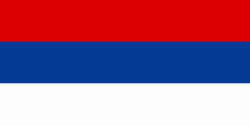Republika Srpska (Republika Srpska)
 |
 |
In the name Republika Srpska, Srpska is a noun derived from the ethnonym of the Serbs with a different suffix than Srbija ‘Serbia’. In Serbian, many names of countries are formed with the -sk- suffix (e.g. Bugarska ‘Bulgaria’, Danska ‘Denmark’, Finska ‘Finland’, Hrvatska ‘Croatia’, Irska ‘Ireland’, Turska ‘Turkey’). An analogous English formation would be Serbland (which has been used sporadically ). Since the suffix -sk- originally forms adjectives and the country names of this type are nominalisations, Republika Srpska has often been misunderstood to mean ‘Serb Republic’. However, the noun Srpska is often used without Republika as a stand-alone noun in Serbian, e.g. in the names of the political party United Srpska (Ujedinjena Srpska), of the newspaper Glas Srpske, of the postal service Pošte Srpske or of the entity's writers’ association (Udruženje književnika Srpske). As a proper noun, Srpska is always capitalised in Serbian, whereas postponed adjectives in names and titles are not (cf. the cultural organisation Matica srpska, with a small s in the adjective srpska ‘Serbian’). The government uses the name “Republic of Srpska” in English.
Although Republika Srpska is variously glossed in English as “Serb Republic”, “Bosnian Serb Republic”, or “Republic of Srpska”, the Constitution of Bosnia and Herzegovina and English-language news sources such as the BBC, The New York Times, and The Guardian generally refer to the entity by its transliteration.
According to Glas Srpske, a Banja Luka daily, the modern entity's name was created by its first minister of culture, Ljubomir Zuković.
Map - Republika Srpska (Republika Srpska)
Map
Country - Bosnia_and_Herzegovina
 |
 |
| Flag of Bosnia and Herzegovina | |
The area that is now Bosnia and Herzegovina has been inhabited by humans since at least the Upper Paleolithic, but evidence suggests that during the Neolithic age, permanent human settlements were established, including those that belonged to the Butmir, Kakanj, and Vučedol cultures. After the arrival of the first Indo-Europeans, the area was populated by several Illyrian and Celtic civilizations. Culturally, politically, and socially, the country has a rich and complex history. The ancestors of the South Slavic peoples that populate the area today arrived during the 6th through the 9th century. In the 12th century, the Banate of Bosnia was established; by the 14th century, this had evolved into the Kingdom of Bosnia. In the mid-15th century, it was annexed into the Ottoman Empire, under whose rule it remained until the late 19th century. The Ottomans brought Islam to the region, and altered much of the country's cultural and social outlook.
Currency / Language
| ISO | Currency | Symbol | Significant figures |
|---|---|---|---|
| BAM | Bosnia and Herzegovina convertible mark | KM or КМ | 2 |
| ISO | Language |
|---|---|
| BS | Bosnian language |
| HR | Croatian language |
| SR | Serbian language |































